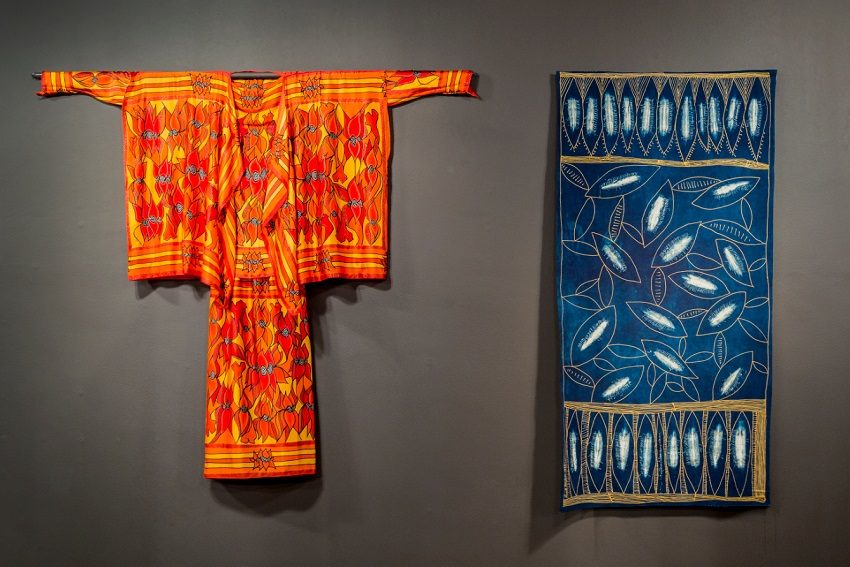A Thread Runs Through It: Linda Jackson and Utopia

Making batik is an intricate and time-consuming craft. Once a design has been drawn onto cloth, part of the pattern is blocked out with hot wax before the cloth is dipped into a dye pot. When the colour has set, the wax is removed with boiling water to reveal the undyed parts of the design.
This method can then be repeated several times with different parts of the design covered in wax and different colours of dye applied. The result is a cloth completely covered in a complex design and a multitude of colours.
Linda Jackson is an iconic Australian fashion designer and artist. Her creative journey started in Melbourne in the late ‘60s from where she set out on a voyage of discovery across Asia and Europe before returning to Sydney in the early ‘70s. Her fashion and photography education combined with her exposure to diverse cultures culminated in a line of fashion and fabric art, created in collaboration with close friend and kindred spirit Jenny Kee. During the ‘80s Jackson travelled across Central Australia and the northern outback areas of Western Australia and Queensland, visiting several Indigenous communities. It was on one of these trips that she met the women of Utopia Station north-east of Alice Springs. This led to a new partnership and collaboration with far-reaching influence and recognition.
 Installation view of Linda Jackson and Utopia, Art Gallery of South Australia, Adelaide, 2017, featuring Linda Jackson, Santa Teresa outfit 1997, Santa Teresa, gutta on silk chiffon, courtesy the artist. Photo Saul Steed
Installation view of Linda Jackson and Utopia, Art Gallery of South Australia, Adelaide, 2017, featuring Linda Jackson, Santa Teresa outfit 1997, Santa Teresa, gutta on silk chiffon, courtesy the artist. Photo Saul Steed
The Utopia Women’s Batik Group was formed in 1978 when Jenny Green conducted a series of government-sponsored workshops with the Alyawarr and Anmatyerr women of Utopia. Batik, a craft originally from Java, was quickly adopted by the women to produce lengths of fabric depicting the desert plants and animals they were familiar with. The work produced by these women received international acclaim and are represented in many collections and museums across the world, including here at the Art Gallery of SA.
The collaboration between Jackson and the women of Utopia embraced so much more than just two sets of textile artists. Both parties, with roots in Australia and influenced by the cultures of Asia, adapted these cross-cultural influences to tell the stories of their own heritage and home.
“The Aborigines’ rainbow – ochres, yellow, reds, and browns, white and black – all pigments obtained from earth,” Jackson says. “Painting and printing with these colours conjure up the magic of the land that has led me to discover the arts of the Aboriginal
people.
“I loved watching the artists sitting around the fire, creating their batiks, marking their stories onto silk and cotton. The batik technique seemed to suit the heat and red dust of the desert. I felt connected to the Utopia women through the medium of textile and batik. Meeting these women in their place made my heart sing!”
 Installation view of Linda Jackson and Utopia, Art Gallery of South Australia, Adelaide, 2017. Photo Saul Steed
Installation view of Linda Jackson and Utopia, Art Gallery of South Australia, Adelaide, 2017. Photo Saul Steed
While the women of Utopia went on to develop their batik skills and unique designs to international acclaim, Jackson used the fabric created by these women to design a line of clothes which she incorporated into her Bush Couture collection. Jackson’s work has been exhibited worldwide and is included in many acclaimed collections including the NGV and Art Gallery of SA.
Just like the process of making batik, the collaboration between Jackson and the women from Utopia is an intricate and time-consuming affair. The process started with a design or a plan and was build up over time in layers of glorious colour. And just like the hot wax in batik, the heat of the desert protected some of the cloth while colouring other parts of it. The end result is a complex design of cloth, clothes, friendship and mutual respect, in all the glorious hues of the desert earth.
Linda Jackson and Utopia
Art Gallery of SA
Until Sunday, October 29
artgallery.sa.gov.au
Header image: Installation view of Linda Jackson and Utopia, Art Gallery of South Australia, Adelaide, 2017, featuring L-R: Linda Jackson, Sturts Desert Pea outfit, 1990-91, 1983, Sydney, silk screen on cotton and silk, courtesy the artist; Indigo gold-eyelashes textile, 1999, Sydney, indigo dye, gold paint on cotton, South Australian Government Grant,1999; Photo Saul Steed